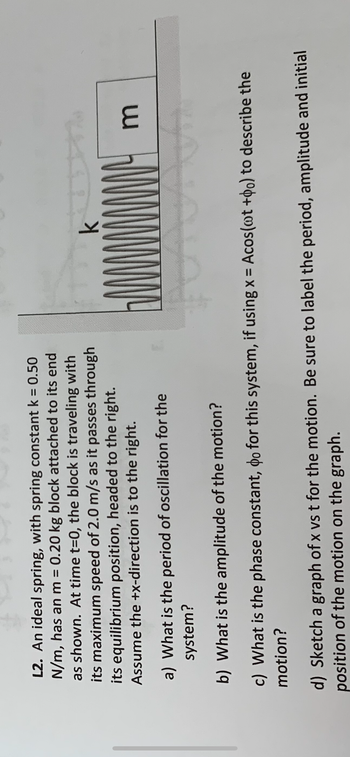
College Physics
11th Edition
ISBN: 9781305952300
Author: Raymond A. Serway, Chris Vuille
Publisher: Cengage Learning
expand_more
expand_more
format_list_bulleted
Concept explainers
Topic Video
Question
i need help with the following question please

Transcribed Image Text:L2. An ideal spring, with spring constant k = 0.50
N/m, has an m = 0.20 kg block attached to its end
as shown. At time t=0, the block is traveling with
its maximum speed of 2.0 m/s as it passes through
its equilibrium position, headed to the right.
Assume the +x-direction is to the right.
k
3
a) What is the period of oscillation for the
system?
b) What is the amplitude of the motion?
c) What is the phase constant, do for this system, if using x = Acos(wt +po) to describe the
motion?
d) Sketch a graph of x vs t for the motion. Be sure to label the period, amplitude and initial
position of the motion on the graph.
Expert Solution
This question has been solved!
Explore an expertly crafted, step-by-step solution for a thorough understanding of key concepts.
This is a popular solution
Trending nowThis is a popular solution!
Step by stepSolved in 4 steps with 4 images

Knowledge Booster
Learn more about
Need a deep-dive on the concept behind this application? Look no further. Learn more about this topic, physics and related others by exploring similar questions and additional content below.Similar questions
- Two vectors are given by ?→=10?̂ +1.4?̂�→=10�̂+1.4�̂ and ?→=1.7?̂ +2.0?̂�→=1.7�̂+2.0�̂. Find (a)|||?→×?→||||�→×�→|, (b)?→⋅?→�→⋅�→, (c)(?→+?→)⋅?→(�→+�→)⋅�→, and (d) the component of ?→�→ along the direction of ?→�→?arrow_forwarddetermine the magnitude and orientation theta of FB so that the resultant force is directed along the positive y axis and has a magnitude of 1500N.arrow_forwardCalculate the angle between the vectors A=(5;4) and B=(2;8)arrow_forward
- "What is the angle between two vectors A and B given that Ax =3, Ay = -2, Bx =2, and By =3?"arrow_forwardAnswer must be in standard form scientific notation with SI units that do not have prefixes ( except for kg.) all angles and directions must be calculated to the nearest 0.1 deg. (Tenth of a degree) and entered in standard form scientific notation.arrow_forward[32] the similarity transformation Pt AP. Let A = . Obtain the matrix P, and diagonalise the matrix A usingarrow_forward
arrow_back_ios
arrow_forward_ios
Recommended textbooks for you
 College PhysicsPhysicsISBN:9781305952300Author:Raymond A. Serway, Chris VuillePublisher:Cengage Learning
College PhysicsPhysicsISBN:9781305952300Author:Raymond A. Serway, Chris VuillePublisher:Cengage Learning University Physics (14th Edition)PhysicsISBN:9780133969290Author:Hugh D. Young, Roger A. FreedmanPublisher:PEARSON
University Physics (14th Edition)PhysicsISBN:9780133969290Author:Hugh D. Young, Roger A. FreedmanPublisher:PEARSON Introduction To Quantum MechanicsPhysicsISBN:9781107189638Author:Griffiths, David J., Schroeter, Darrell F.Publisher:Cambridge University Press
Introduction To Quantum MechanicsPhysicsISBN:9781107189638Author:Griffiths, David J., Schroeter, Darrell F.Publisher:Cambridge University Press Physics for Scientists and EngineersPhysicsISBN:9781337553278Author:Raymond A. Serway, John W. JewettPublisher:Cengage Learning
Physics for Scientists and EngineersPhysicsISBN:9781337553278Author:Raymond A. Serway, John W. JewettPublisher:Cengage Learning Lecture- Tutorials for Introductory AstronomyPhysicsISBN:9780321820464Author:Edward E. Prather, Tim P. Slater, Jeff P. Adams, Gina BrissendenPublisher:Addison-Wesley
Lecture- Tutorials for Introductory AstronomyPhysicsISBN:9780321820464Author:Edward E. Prather, Tim P. Slater, Jeff P. Adams, Gina BrissendenPublisher:Addison-Wesley College Physics: A Strategic Approach (4th Editio...PhysicsISBN:9780134609034Author:Randall D. Knight (Professor Emeritus), Brian Jones, Stuart FieldPublisher:PEARSON
College Physics: A Strategic Approach (4th Editio...PhysicsISBN:9780134609034Author:Randall D. Knight (Professor Emeritus), Brian Jones, Stuart FieldPublisher:PEARSON

College Physics
Physics
ISBN:9781305952300
Author:Raymond A. Serway, Chris Vuille
Publisher:Cengage Learning

University Physics (14th Edition)
Physics
ISBN:9780133969290
Author:Hugh D. Young, Roger A. Freedman
Publisher:PEARSON

Introduction To Quantum Mechanics
Physics
ISBN:9781107189638
Author:Griffiths, David J., Schroeter, Darrell F.
Publisher:Cambridge University Press

Physics for Scientists and Engineers
Physics
ISBN:9781337553278
Author:Raymond A. Serway, John W. Jewett
Publisher:Cengage Learning

Lecture- Tutorials for Introductory Astronomy
Physics
ISBN:9780321820464
Author:Edward E. Prather, Tim P. Slater, Jeff P. Adams, Gina Brissenden
Publisher:Addison-Wesley

College Physics: A Strategic Approach (4th Editio...
Physics
ISBN:9780134609034
Author:Randall D. Knight (Professor Emeritus), Brian Jones, Stuart Field
Publisher:PEARSON